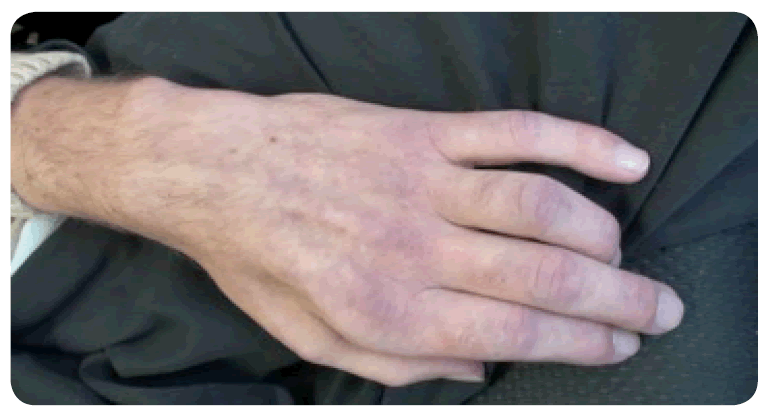Abdulla, Susanne1, 2, 3, Conrad, Anton4, Vielhaber, Stefan1,3, Petri, Susanne2
1Department of Neurology, Otto von Guericke University Magdeburg, Leipziger Str. 44, D-39120 Magdeburg, Germany.
2Department of Neurology, Hannover Medical School, Carl-Neuberg-Str. 1, D-30625 Hannover, Germany.
3German Center for Neurodegenerative Diseases, Leipziger Str. 44, D-39120 Magdeburg, Germany.
4Department of Pneumology, Hannover Medical School, Carl-Neuberg-Str. 1, D-30625 Hannover, Germany.
*Corresponding Author:
Abdulla Susanne
E-mail: Abdulla.Susanne@mh-hannover.de
All persons listed as authors in the manuscript have made substantial contribution, so as to take public responsibility to it.
Sympathoadrenergic reaction in an ALS patient with severe respiratory insufficiency: bluish discoloured, pale and clammy left hand with prominent atrophy of the first dorsal interosseous

Amyotrophic lateral sclerosis (ALS) is an incurable neurodegenerative disease with progressive paralysis of skeletal muscles. Impairment of respiratory muscles results in respiratory failure which is the most common cause of death in ALS [1]. There is evidence that treatment with noninvasive ventilation (NIV) significantly prolongs survival and improves or maintains quality of life in patients with ALS. Furthermore, NIV is an effective means of palliating symptoms in these patients [2, 3]. This is illustrated by the case of a 49-year-old man who presented with a 40-months history of ALS with severe tetraparesis and bulbar involvement (ALSFRS-R score 9/48, corresponding to severe functional impairment in advanced disease stage). He had been on NIV for 10 months, currently 20-h a day. Tracheostomy and invasive ventilation was declined. When pausing NIV for routine examination, he suffered from moderate dyspnea in sitting position (Borg dyspnea scale 3) and inability to lie supine due to orthopnea. Forced vital capacity was 0.85 liter (17% of predicted) and sniff nasal inspiratory pressure did not exceed 4 cmH2O. Blood gas analysis showed neither hypoxemia nor hypercapnia (pCO2 44 mmHg, pO2 86 mmHg). Interruption of NIV led to pale-bluish discoloration and cold sweats of both hands which was completely reversible on NIV resumption. We interpret these symptoms as sympathoadrenergic reaction from severe respiratory distress upon discontinuation of NIV. It illustrates that NIV is capable to at least temporarily alleviate advanced respiratory impairment in ALS patients.
The patient eventually died three and a half months later due to respiratory failure while using NIV 24 hours a day and receiving comfort care in a palliative care unit.
1955
References
- Gruis, KL., Lechtzin, N. Respiratory therapies for amyotrophic lateral sclerosis: A primer. Muscle Nerve 2012; 46 (3): 313-331.
- Bourke, SC., Tomlinson, M., Williams, TL., Bullock, RE., Shaw, PJ., Gibson, GJ. Effects of non-invasive ventilation on survival and quality of life in patients with amyotrophic lateral sclerosis: A randomised controlled trial. Lancet neurology 2006; 5 (2): 140-147.
- Radunovic, A., Annane, D., Rafiq, MK., Mustfa, N. Mechanical ventilation for amyotrophic lateral sclerosis/motor neuron disease. Cochrane Database Syst Rev. 2013 Mar 28;3:CD004427






